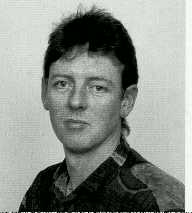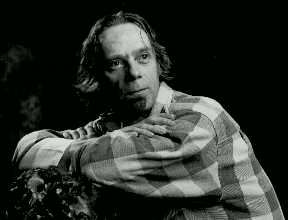
CELTIC ART EXHIBITION
ALAN KENNY
Ireland

Alan Kenny, a native of Dublin, is probably one of Ireland's most diverse artists. His paintings range from realistic landscapes to Dali surrealism.
In the early seventies he was better known in Dublin music circles as a very talented musician and was also a qualified electrician.
However the urge to visually express himself led Alan into oil painting where he studied under the noted Irish landscape artist Gerry Majoram.
For several years Alan perfected his techniques in landscape painting, depicting scenes of Connemara, Kerry and Donegal where he found the lighting and colours to his liking.
He became one of the top selling artists both in Clifden and Dublin but this was not enough for Alan. His greater talent had yet to develop abd finally forced itself to the surface in 1992.
In the last five years, and particularly in the last three years, Alan spent his time devoted to new techniques and new mediums developing his varied styles.
Like a recluse, he spent every waking minute experimenting and developing his latent talent. These paintings are the result of these hard years of intense development and creativity. At last his potential can be seen in its full glory.
Examples of Alan's works can be seen at the Lavelle Gallery in Galway, Ireland. One example of Alan's new style of work is, 'Trad Session'

Trad. Session.
JAMES SUMMERS
Scotland

The artist has worked in the field of Celtic illumination for over ten years, when a general interest in calligraphy of various styles and period developed into more specific researches into Scottish/Irish illuminations of the early Christian church, as exemplified by many impressive surviving works of this period, notably the Book of Kells.
This interest grew into a determination to reproduce the style and mood of these superb works, a sort of return to his Celtic roots, and a homage to those ancient, largely unknown artists.
The intricacy and accuracy of this type of illumination demand intense patience and concentration from the artist and the result, though impressive, is incredibly labour-intensive. Those ancient monkisk craftsmen would spend hundreds of hours on the embellishment of a single page to the glory of God, and the artist, in an attempt tp re-create the same effects, makes a conscious decision to use, wherever possible, largely traditional materials, such as inks, genuine parchment and gold leaf. He eschews the use of modern computer technology, which he feels negates the personal creative spirit of the work and prefers to work entirely by hand and eye.
Although the Celtic tradition is exemplified by certain features, such as the elaborate knot work,and the incorporation of stylised birds and animals, it is by no means rigid and working within its framework in no way denies the artist's own creativity.
The artist's rediscovery of the world of Celtic art, was happily followed by a more general, world-wide interest, in the spirit of the New Age, in various forms of ancient mysticism and their artistic embodiments. What started as a purely personal passion quickly attracted a widespread appreciation, and the artist found himself in demand for various projects and commissions, such as book illustration, commemorative scrolls, and the annually awaited limited edition Celtic Christmas cards.
The artist has exhibited locally, but also in Londo abd Edinburgh, and most recently took part in the "Braveheart" exhibit in Stirling, commemorating William Wallace.
Although originally practised only in Scotland and Ireland, and fallen into disuse for many centuries, the appeal of this wonderfully complex art form transcends geographical boundaries, and the artistis gratified to help it re-emerge from the dust of centuries, and to create works which will charm and delight also the modern age.
James Summers was born and lives in Peterhead, Scotland. He divides his time between an oil platform in the North Sea and his onshore studio.
[HOME] [CONTENTS] [PROGRAMME(L)] [PROGRAMME(T)]